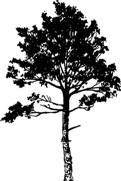|
SILVICS OF YELLOW BIRCH
(Betula alleghaniensis Britt.)
Common names:
- curly birch, hard birch, black birch
Field identification aids:
- leaves are oval shaped with many teeth along the margins
- yellow to golden papery bark that peels off in thin strips
- bark of older tree is platy and dark
Average mature tree:
- 70 to 90 years old
- 18 m to 24 m (60' to 80') tall
- 30 cm to 60 cm (12" to 24") in diameter at breast height
Maximum life span:
- 300 years
Shade tolerance:
- medium
Rooting:
- deep, wide-spreading lateral roots
Windfirmness:
- windfirm on well drained soils
Reproduction:
- reproduces by seed or stump sprouting
- seed may begin to produce seed when 40 years old, with full production after 70 years
- good seed crop production every 1 to 2 years
- poor germination on undisturbed litter layer
- best seed germination occurs on a moist mixture of humus and mineral soil
Growing sites:
- range from well-drained to poorly-drained soils
- usually found on moderate to well-drained soils
Associated species:
- black spruce and red maple on poorly-drained sites
- sugar maple, red maple, beech, red spruce, eastern hemlock and balsam fir on well-drained sites
- seldom found in pure stands in Nova Scotia
Principal damaging agents:
- nectria canker birch leaf skeletonizer, white-marked tussock moth, bronze birch borer
- birch dieback causes some mortality
Notes:
- yellow birch comprises 5.1 % of themerchantable volume in Nova Scotia
- favorite hardwood browse of deer
- the tree often has stilted roots due to germination occurring on dead tree or stump
- one of Nova Scotia’s most valuable native birches
- commonly used for flooring, furniture, cabinet work, and veneer
|


